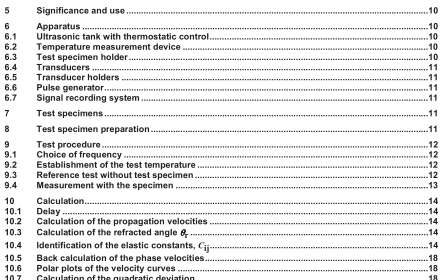EN 14186:2007 – Advanced technical ceramics – Mechanical properties of ceramic composites at room temperature – Determination of elastic properties by an ultrasonic technique

1 Scope
This European Standard specifies an ultrasonic method to determine the components of the elasticity tensor of ceramic matrix composite materials at room temperature. Young’s moduli, shear moduli and Poisson coefficients,can be determined from the components of the elasticity tensor.
This European Standard applies to ceramic matrix composites with a continuous fibre reinforcement: unidirectional (1D), bidirectional (2D), and tridirectional (×D, with 2 < × ≤ 3) which have at least orthotropic symmetry, and whose material symmetry axes are known.
This method is applicable only when the ultrasonic wave length used is larger than the thickness of the representative elementary volume, thus imposing an upper limit to the frequency range of the transducers used.
NOTE Properties obtained by this method might not be comparable with moduli obtained by EN 658-1, EN 658-2 and EN 12289.
2 Normative references
The following referenced documents are indispensable for the application of this document. For dated references,only the edition cited applies. For undated references, the latest edition of the referenced document (including any amendments) applies.
EN 1389, Advanced technical ceramics — Ceramic composites — Physical properties — Determination of density and apparent porosity
CEN/TR 13233:2007, Advanced technical ceramics — Notations and symbols
EN ISO/IEC 17025, General requirements for the competence of testing and calibration laboratories (ISO/IEC 17025:2005)
ISO 3611, Micrometer callipers for external measurements
3 Terms and definitions
For the purposes of this document, the terms and definitions given in CEN/TR 13233:2007 and the following apply.
3.1
stress-strain relations for orthotropic material
elastic anisotropic behaviour of a solid homogeneous body described by the elasticity tensor of fourth order C ijkl ,
represented in the contracted notation by a symmetrical square matrix (6 × 6)
NOTE 1 If the material has at least orthotropic symmetry, its elastic behaviour is fully characterised by nine independent tiffness components C ij , of the stiffness matrix (C ij ), which relates stresses to strains, or equivalently by nine independent compliance components S ij of the compliance matrix (S ij ), which relates strains to stresses. The stiffness and compliance matrices are the inverse of each other.
If the reference coordinate system is chosen along the axes of symmetry, the stiffness matrix C ij and the compliance matrix S ij can be written as follows:
EN 14186:2007 – Advanced technical ceramics – Mechanical properties of ceramic composites at room temperature – Determination of elastic properties by an ultrasonic technique